Corrugation for ventilation: choose and install yourself
In this article we will talk about what constitutes an aluminum corrugation for ventilation and similar products from other materials. In addition, we consider what are the features of the choice of these structures. Well and, of course, we will give a number of practical recommendations for the installation of ventilation corrugations.
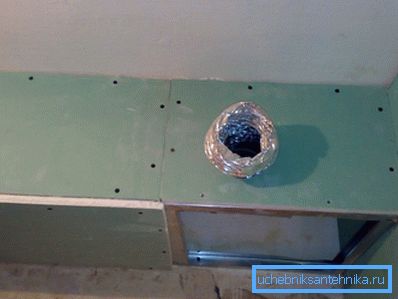
General information
Ventilation corrugated pipe is an essential element for connecting modern hoods. There is no doubt that the ventilation corrugated sleeve does not look as neat as a special plastic box.
The fact is that the round sleeve is difficult to hide in the wall or cover with any decorative elements. But, despite these difficulties, in some cases, a corrugated hose is simply irreplaceable.
For example, a corrugated pipe for ventilation is used in hard-to-reach places, where, due to multiple turns and bends, it is difficult to mount an ordinary plastic box.
The main types of air ducts and their classification
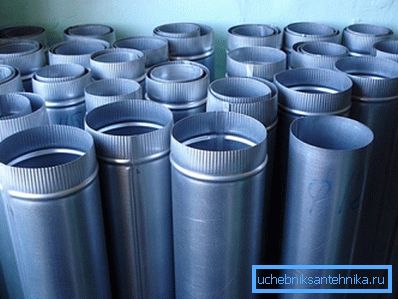
Currently, air ducts designed to attach hoods are represented by the following modifications.
- Plastic or metal pipe (hard box) with a perfectly smooth inner surface. The lack of internal relief ensures noiseless operation of ventilation equipment. The smooth exterior surface, in turn, ensures the aesthetics of the appearance of the connecting element.

The only significant drawback of such constructions is a small degree of flexibility and, as a result, the impossibility of using it on walls and ceilings with complex surface relief.
It is advisable to use plastic air ducts when they can be covered with a suspended ceiling, decorative panels and other protective structures. The price of a plastic duct is high compared to metal counterparts.
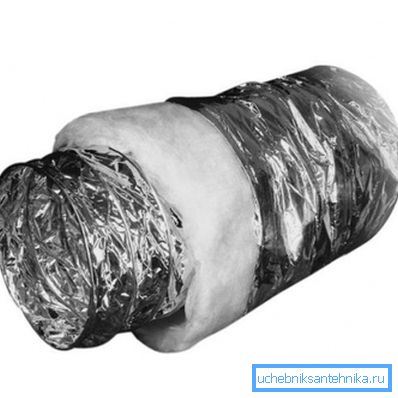
- Corrugated aluminum pipe for ventilation is a more relevant and popular option, as it has a number of advantages, among which we note the following:
- high wear resistance;
- resistance to mechanical deformations;
- ease of installation work;
- low degree of load on building floors
- absolute tightness, despite the mobility of the joints;
- resistance to elevated temperatures (up to + 250 ° C) and, as a consequence, the possibility of use for exhaust gases in autonomous heating systems;
- universality of use, as the corrugation with the same success is operated in the premises of public, housing and technical purposes;
- reasonable price and, as a result, the attractive cost of the finished ventilation system as a whole.
However, along with obvious advantages, there are at least obvious shortcomings, among which are:
- low level of rigidity of the ventilation duct as a whole;
- low intensity of the air flow due to insufficient aerodynamics of the inner surface of the walls;
- the difficulty of diagnosing damage or blockages, as well as the difficulty of cleaning and disinfecting the ventilation ducts;
- Due to a number of structural features, flexible aluminum ducts cannot be used in high-performance ventilation systems.
Construction features
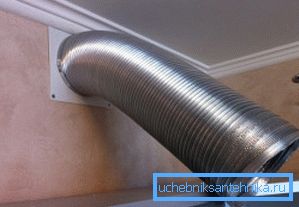
Flexible air ducts are structurally a multi-layer product made of aluminum and a layer of polyester. The reinforcing element of a design is the spiral from steel. The spiral not only sets the required degree of rigidity to the product, but also provides for the change in the direction of the pipe on turns in the form of a characteristic harmonica.
Aluminum air ducts from the inside can be smooth or corrugated.
- Modifications with a smooth inner surface are characterized by increased aerodynamic properties.. Therefore, it is advisable to install such modifications of air ducts on long-haul routes.
A significant drawback of modifications with a smooth inner surface of the walls is a more complex installation.
- Corrugated aluminum air ducts are characterized by less aerodynamics, but, despite this drawback, they can be set to any desired direction, which greatly simplifies installation.
Selection features
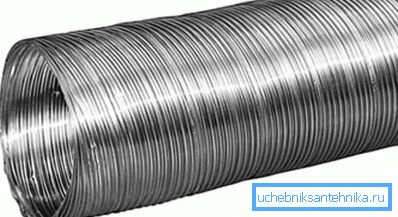
What to look for when choosing a corrugated duct for ventilation? Since the technology of installation and operation of these connecting elements is the same, regardless of the manufacturer's brand, we focus on the diameter of the cross section.
As a result, in order to make the right choice, you must be guided by the parameters of the outlet of the equipment that you plan to attach through a flexible duct.
If the drawing instruction involves the use of corrugations of a certain diameter, it is this diameter that should be used, since the discrepancy between the actual dimensions and the indicated dimensions will lead to impossibility of installation or to insufficient tightness of the connection.
Standard diameters of industrially manufactured aluminum corrugations are as follows:
- 200 mm;
- 150 mm;
- 125 mm;
- 100 mm.
As a rule, the listed sizes are sufficient for the installation of all industrially produced extracts and other equipment that needs to be connected to a ventilation system.
Important: When purchasing a duct for domestic exhaust, you should remember that the ventilation duct with a large number of right angles and a length of over 2 meters negatively affects the performance of the system. The solution to this problem can be the acquisition of a smaller channel with a smaller diameter, which can be attached to the hood through an adapter.
Selection according to the presence of insulation
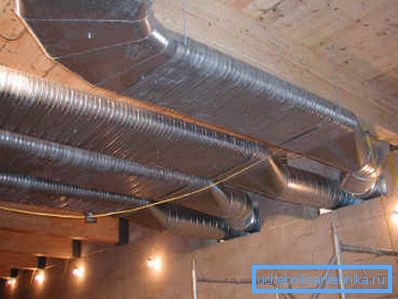
The price of flexible aluminum ducts depends largely on the presence of an intermediate layer of insulation. Modifications without any insulation are installed and operated in the system of forced ventilation, where there are no special requirements to the level of noise and fire safety.
Modifications with a layer of insulation are an order of magnitude more expensive than conventional counterparts, but, despite the higher price, they guarantee a number of significant advantages, including: low noise level, high resistance to high temperatures.
A layer of mineral wool is used as insulation in such constructions. As a result, the design of the isolated modifications is a sandwich consisting of an aluminum layer, a cotton layer and an aluminum layer.
Multilayer structures are widely used in cases where the highway is laid through rooms where a high level of noise is unacceptable.
Installation work
When assembling in the kitchen, the corrugated ventilation sleeve is made to be hidden in one of the wall cabinets. Another good option is the location of the pipe in the space above the kitchen set.
For installation, no special adapters are required, as the pipe is flexible and passes through all angles without any effort.
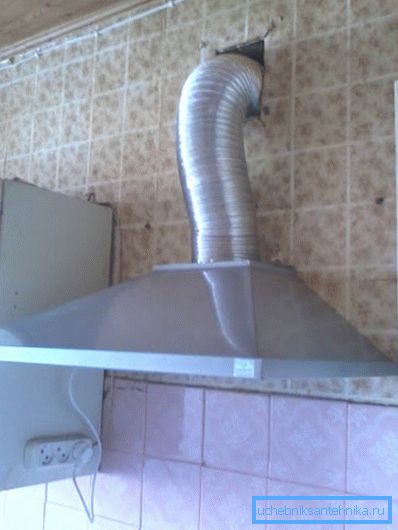
The manual installation manual does not represent anything difficult:
- At first we stretch the air duct in order to have less noise when the finished system is operating.
- Fasten the pipe to the exhaust system pipe, using a special clamp. Similarly, the corrugation is fixed on the exhaust hole.
- If the exhaust device with a round section is attached to it directly corrugation. If the hole is rectangular, purchase a special adapter or channel with a rectangular cross-sectional shape.
Important: The use of adapters reduces system performance. It is advisable to immediately purchase an air duct of the same shape and size as at the exhaust port, in order not to sacrifice performance and not to operate the hood in an enhanced mode.
- At the end of the vent, it is advisable to install a fine-meshed grating in order to prevent the penetration of various insects and dirt from the outside. However, during operation, this grate will have to be cleaned regularly to prevent blockages and degradation of system performance.
Conclusion
So, we talked about the main types of air ducts used in the device of household ventilation systems. Moreover, we considered the features of the selection and installation of flexible corrugations.
You can find more useful information by watching the video in this article.